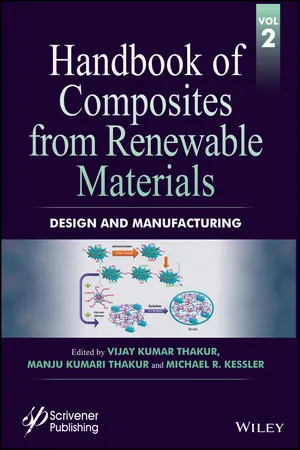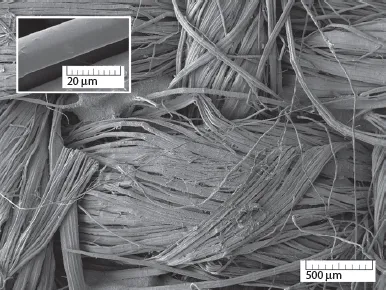
Handbook of Composites from Renewable Materials, Design and Manufacturing
- English
- ePUB (mobile friendly)
- Available on iOS & Android
Handbook of Composites from Renewable Materials, Design and Manufacturing
About this book
This unique multidisciplinary 8-volume set focuses on the emerging issues concerning synthesis, characterization, design, manufacturing and various other aspects of composite materials from renewable materials and provides a shared platform for both researcher and industry.
The Handbook of Composites from Renewable Materials comprises a set of 8 individual volumes that brings an interdisciplinary perspective to accomplish a more detailed understanding of the interplay between the synthesis, structure, characterization, processing, applications and performance of these advanced materials. The Handbook comprises 169 chapters from world renowned experts covering a multitude of natural polymers/ reinforcement/ fillers and biodegradable materials.
Volume 2 is solely focused on the Design and Manufacturing of renewable materials. Some of the important topics include but not limited to: Design and manufacturing of high performance green composites; manufacturing of high performance biomass-based polyesters by rheological approach; components design of fibrous composite materials; design and manufacturing of bio-based sandwich structures; design and manufacture of biodegradable products from renewable resources; manufacturing and characterization of quicklime filled metal alloy composites for single row deep groove ball bearing; manufacturing of composites from chicken feathers and poly (vinyl chloride); production of porous carbons from resorcinol-formaldehyde gels: applications; composites using agricultural wastes; manufacturing of rice wastes-based natural fiber polymer composites from thermosetting vs. thermoplastic matrices; thermoplastic polymeric composites; natural fiber reinforced PLA composites; rigid closed-cell PUR foams containing polyols derived from renewable resources; preparation and application of the composite from alginate; recent developments in biocomposites of bombyx mori silk fibroin; design and manufacturing of natural fiber/ synthetic fiber reinforced polymer hybrid composites; natural fiber composite strengthening solution for structural beam component for enhanced flexural strength; high pressure resin transfer molding of epoxy resins from renewable sources; cork based structural composites; the use of wheat straw as an agricultural waste in composites for semi-structural applications and design/ manufacturing of sustainable composites.
Frequently asked questions
- Essential is ideal for learners and professionals who enjoy exploring a wide range of subjects. Access the Essential Library with 800,000+ trusted titles and best-sellers across business, personal growth, and the humanities. Includes unlimited reading time and Standard Read Aloud voice.
- Complete: Perfect for advanced learners and researchers needing full, unrestricted access. Unlock 1.4M+ books across hundreds of subjects, including academic and specialized titles. The Complete Plan also includes advanced features like Premium Read Aloud and Research Assistant.
Please note we cannot support devices running on iOS 13 and Android 7 or earlier. Learn more about using the app.
Information
Chapter 1
Design and Manufacturing of High-Performance Green Composites Based on Renewable Materials
Abstract
1.1 Introduction

- Lower environmental impact during fiber production
- Typically higher fiber content if natural fibers are used (to reach comparable performance)
- Lower density results in better light-weight performance and reduces fuel consumption and emissions, for example, in automotive applications
- End of life incineration results in carbon credits and recovered energy
1.2 Bio-Based Epoxy Matrix – State-of-the-Art
Table of contents
- Cover
- Title page
- Copyright page
- Dedication
- Preface
- Chapter 1: Design and Manufacturing of High-Performance Green Composites Based on Renewable Materials
- Chapter 2: Manufacturing of High Performance Biomass-Based Polyesters by Rheological Approach
- Chapter 3: Design of Fibrous Composite Materials for Saving Energy
- Chapter 4: Design and Manufacturing of Bio-Based Sandwich Structures
- Chapter 5: Design and Manufacture of Biodegradable Products from Renewable Resources
- Chapter 6: Manufacturing and Characterization of Quicklime (CaO) Filled ZA-27 Metal Alloy Composites for Single-Row Deep Groove
- Chapter 7: Manufacturing of Composites from Chicken Feathers and Polyvinyl Chloride (PVC)
- Chapter 8: Production of Porous Carbons from Resorcinol-Formaldehyde Gels: Applications
- Chapter 9: Composites Using Agricultural Wastes
- Chapter 10: Manufacturing of Rice Waste-Based Natural Fiber Polymer Composites from Thermosetting vs. Thermoplastic Matrices
- Chapter 11: Thermoplastic Polymeric Composites and Polymers: Their Potential in a Dialogue Between Art and Technology
- Chapter 12: Natural Fiber Reinforced PLA Composites: Effect of Shape of Fiber Elements on Properties of Composites
- Chapter 13: Rigid Closed-Cell PUR Foams Containing Polyols Derived from Renewable Resources: The Effect of Polymer Composition, Foam Density, and Organoclay Filler on Their Mechanical Properties
- Chapter 14: Preparation and Application of the Composite from Alginate
- Chapter 15: Recent Developments in Biocomposites of Bombyx mori Silk Fibroin
- Chapter 16: Design and Manufacturing of Natural Fiber/Synthetic Fiber Reinforced Polymer Hybrid Composites
- Chapter 17: Natural Fiber Composite Strengthening Solution for Structural Beam Component for Enhanced Flexural Strength, as Alternatives to CFRP and GFRP Strengthening Techniques
- Chapter 18: High Pressure Resin Transfer Moulding of Epoxy Resins From Renewable Sources
- Chapter 19: Cork-Based Structural Composites
- Chapter 20: The Use of Wheat Straw as an Agricultural Waste in Composites for Semi-Structural Applications
- Chapter 21: Design and Manufacturing of Sustainable Composites
- Index
- End User License Agreement